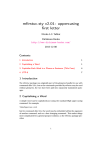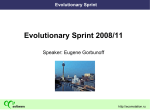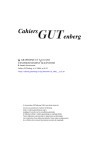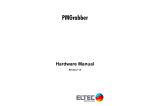Download ePDF reference manual
Transcript
T DR A D RF T AF ePDF Reference Manual for OS/2 and eComStation revision 1.0 DR AF T ePDF reference manual rev 1.0 1. INTRODUCTION T ePDF is a REXX-based tool for PostScript-to-PDF conversion which uses GhostScript as its back-end. With ePDF you are able to create PDF files with user definable document information. AVAILABILITY AF The latest version of ePDF may be found at DR http://www.subsys.de/ePDF/ Page 3 of 29 ePDF reference manual rev 1.0 2. REQUIREMENTS OS/2 or eComStation with REXX installed. http://www.ecomstation.com AF http://www.ghostscript.com/ or http://www.cs.wisc.edu/%7Eghost/ T Installed GhostScript with latest EMX runtime. http://hobbes.nmsu.edu/pub/os2/dev/emx/ A PostScript printer driver, e.g. "ePDF PS" http://www.subsys.de/ePDF/ DR or a driver from IBM's "OS/2 Device Driver Pak On-Line" http://service5.boulder.ibm.com/2bcprod.nsf Req. to print and view PDF files: Acrobat Reader/2 v 3.0 (last native Reader from Adobe) http://www.adobe.com/products/acrobat/readstep2.html or GhostView http://www.cs.wisc.edu/%7Eghost/ or InnoTek OS/2 Kit for Acrobat Reader http://www.innotek.de/products/acrobatos2/acrobatos2general_e.html Page 4 of 29 ePDF reference manual rev 1.0 3. INSTALLATION T Update information: It is recommended to delete older versions of ePDF before you install newer versions. If you have downloaded an archive with an updated ePDF.exe file, it is possible to replace the old ePDF.exe file with the new one. AF Just unzip the archive to a directory on your harddrive. Make sure that the subdirectory 'icons' has been created succesfully. Run install.cmd from a commandline to create objects on your desktop. If not already present, you'll have to manually add the GS_LIB environment variable to your config.sys in order to let ePDF call GhostScript functions. The GS_LIB statement must contain the paths to your active GhostScript ..\lib directory and the path to your OS/2 fonts: e.g. SET GS_LIB=D:\gstools\gs8.11\lib;C:\PSFONTS; DR Alternatively, you may add the paths to the Distiller libpath field in the program's properties dialog, e.g. D:\gstools\gs8.00\lib;C:\PSFONTS Please note that the above setting will override the GS_LIB statement in your config.sys which allows you to use a different GhostScript version for ePDF than the one used by GSView or other software. Also, in order for GhostScript to work correctly with ePDF, you'll have to take care of the proper FONTMAPPING which involves renaming the file 'Fontmap.OS2' to 'Fontmap' (without quotes) in the ..\lib directory of your GhostScript installation. For further details, please refer to the GS documentation. Attention: the command interpreter "4OS2" is currently not supported! Page 5 of 29 ePDF reference manual rev 1.0 4. SETUP After the first start please open the properties notebook and go through all pages. T Page 1: distiller setup DR AF 4.1 Select the 'add' button to create a new distiller setup, or select 'change' to edit the settings of an existing setup. Page 6 of 29 ePDF reference manual rev 1.0 AF T Then the dialog window for the distiller setting will be opened. Enter a label for this setup. This is the name that will be used f or the menu item in the main window. Dupes are not allowed, each distiller label must have a unique name. DR Enter the full path to gsos2.exe including the drive in the corresponding entry field, e.g. D:\gstools\gs8.11\bin\gsos2.exe If you leave this entry field, ePDF will try to locate the lib and the PostScript font directory. If it is successfully, then the directories will be automatically entered into the last entry field. This will happen only if the entry field is empty. Take a look at the directories, and if necessary correct and complete them. Directories must be separated by a semicolon. Do not enter spaces! Hit "OK" to save your settings. Once set in the properties notebook, you may re-select the distiller settings from the main menu for each conversion process. Page 7 of 29 ePDF reference manual rev 1.0 Page 2: profile setup AF T 4.2 DR First, the procedure is the same as on page 1. Select add (or change) to open the setup dialog. In the setup dialog window select the program's execution parameters using the radio buttons, check boxes and spin buttons. Page 8 of 29 ePDF reference manual rev 1.0 DR AF T It is possible to load pre-settings. In the top group of the window select a radio button corresponding to your usage intention: SCREEN selects low-resolution output similar to the Acrobat Distiller "Screen Optimized" setting. EBOOK selects low-resolution output similar to the Acrobat Distiller "Ebook Optimized" setting. PRINTER selects output similar to the Acrobat Distiller "Print Optimized" setting. PREPRESS selects output similar to Acrobat Distiller "Prepress Optimized" setting. DEFAULT selects output intended to be useful across a wide variety of uses, possibly at the expense of a larger output file. Then click "opt". This will load optimal values for each setting. Page 9 of 29 ePDF reference manual rev 1.0 For a detailed explanation of the settings above and additional parameters, please refer to the file PS2PDF.htm in your GhostScript documentation or to the "Adobe Technical Note #5151" at http://partners.adobe.com/asn/developer/acrosdk/DOCS/distparm.pdf T One personal note: Please always use PDF compatibility to version 1.2. This is the only version that we can read with Acrobat Reader 3.0 under OS/2, but all higher versions on other platforms are able to read PDF 1.2. Please support the "portable document format" concept this way. DR AF Once set in the properties notebook, you may re-select the execution parameters from the main menu for each conversion process. Page 10 of 29 ePDF reference manual rev 1.0 Page 3: PDF doc infos AF T 4.3 DR Enter any default values for the PDF doc infos. You may also leave them blank. Leave the 'title' field blank if you want to use the title of the PostScript file (mostly this is the filename of the source document, it differs from application to application) as the title. The defaults will be read and applied to the main window after the program has been launched. They may be overridden for each conversion process. Page 11 of 29 ePDF reference manual rev 1.0 Page 4: PDF file AF T 4.4 DR Enter a valid directory in the first entry field, where the PDF files will be created. Then make your choice how the PDF file names will be generated: Select "PostScript file name" if you wish to generate file names based on the PostScript file. If you convert a ps files called "test.ps" the output file will be called "test.pdf". Or select "source document file name" if you want to use the file name from the source file, e.g. the name of the StarOffice document "document.sdw" will be transcribed to "document.pdf". ePDF will try to read this name from the PostScript file. This works fine with documents created by using printer redirection to a PS file (e.g. with Printmon PS). If you like to use ePDF on a server (using the auto run parameter) to create PDFs without any user interaction, then it's a good idea to enable Page 12 of 29 ePDF reference manual rev 1.0 the option "time prefix". You will get unique file names to avoid overwriting of existing files. Page 5: PDF startup DR AF T 4.5 These document open options are relevant for Acrobat Reader. PDF document open actions: Select which view Acrobat Reader will use by default. standard page - opens the standard view in a window, thumbnails and bookmarks will not be displayed fullscreen - is the same like standard, but the document will be opened in fullscreen mode. Note: Press ESC or Ctrl+L to switch back to window mode. thumbnails - opens the document in a two frame window. At the right you will get the document, at the left you will see the thumbnail panel. Page 13 of 29 ePDF reference manual rev 1.0 bookmarks - opens the document in a two frame window. At the right you will get the document, at the left you will see the bookmark panel. bookmarks, if present - checking this box in combination with standard page is the most usefull setup. PDFs will be opened in standard mode, but if there is a bookmark file, the bookmark panel will be displayed. T expand bookmarks - check this box and all bookmarks will be expanded after opening the PDF file. Otherwise all bookmarks will be collapsed. AF start page - select the page number which will be displayed after launching the PDF file. Note: A value higher than the available document page count will produce a GhostScript error. Currently it is not possible to check the page count from the PostScript file (to compare it with the selected value). So be careful. fit - take a choice how the document will be filled in the Acrobat reader window (fit to page, fit width or fit heigth) DR zoom - lets you specify the zoom factor which will be used by Acrobat Reader. Note: you have to select between fit or zoom. offset left and offset top - specifies the scroll offset after document loading. This is only for advanced users, we recommend to leave the values at zero. 'default' button - loads the defaults for all values. 'undo' button - loads the last saved settings. Note: Settings will be saved after closing the properties notebook. Page 14 of 29 ePDF reference manual rev 1.0 4.6 Page 6: PDF encryption T ePDF supports 40 bit encryption, using encryption revision 2. For encryption with bit lengths longer then 40 we need the output format PDF 1.4, as well as Acrobat Reader 5. Because of the lack of availability of AR 5 under OS/2 this kind of encryption is not yet supported by ePDF. DR AF Encryption requires GhostScript 8.15 (or higher). owner password - this is the password to edit files (e.g. with Acrobat) after distilling. user password - this password is required to display PDFs in Acrobat Reader. There is a little 'encryption' checkbox on the ePDF main window. There you are able to switch encryption ON or OFF. If switched ON, and you want to add an user password to the PDF file, you have to specify an Page 15 of 29 ePDF reference manual rev 1.0 owner password, too. If not specified, ePDF will use the same password for user and owner. At least an owner password is required to enable the encrytion checkbox. Page 7: options DR AF 4.7 T Note: Currently it is not possible to create optimized and encryted PDFs. If both options are selected, ePDF will create an encrypted file without optimization. The PostScript file needs to be modified to include the PDF INFO data prior to conversion. If you don't want this to happen, check "don't modify the postscript file". ePDF will then copy all data to a temporary file which is deleted thereafter. This will slow down the process somewhat, and you will need sufficient free space on your hard disk. If you don't need the PostScript file after successful conversion to PDF, you may chose to automatically delete it. Use this option only if you have NO problems with converting a file (or you may easily recreate it). Page 16 of 29 ePDF reference manual rev 1.0 If you want to use "PrintMon PS", it is a good idea to check "delete PostScript file after conversion", otherwise the additional temporary PS files (created by using PrintMon) will not be deleted. In case you do not select either option, your original PostScript file will remain on your disk, yet modified with the PDF INFO you've added. T To hear a short beep after program completion, please check this option. AF You may enable STDIO to assist your reporting any bugs. This option enables the output of any (error) messages to a REXX console. If required, please copy the contents and send the output to us if you need to report a bug in ePDF. Finally, if you wish that ePDF will be automatically closed after the PDF conversion, then enable the last checkbox. 4.8 ICONS AND BUTTONS DR Feel free to edit the icons in the subdirectory 'icons'. If you delete the icons, the buttons will be labeled with a standard text. 4.9 PRINTMON PS ONLY if you intend to use "PrintMon PS" (the printer queue redirection to ePDF) you have to specify the ePDF port to your printer driver. Open the settings dialog of your postscript driver, select the "output ports" page and chose the '\pipe\ePDF' port. Do NOT select 'output to a file' when using "PrintMon PS" since there is no PostScript file being generated. Feel free to add a shadow of 'PrintMon PS' to your StartUp folder; otherwise you will have to restart 'PrintMon PS' every time you want to use ePDF. Page 17 of 29 ePDF reference manual rev 1.0 5. USE AF T First you must create a PostScript file by redirecting your printer output to a file (NOT required when using "PrintMon PS", see below). We recommend installation of the "HP Designjet 750C/PS" (from the plotters package) driver from IBM. With this driver you can create coloured postscript files with large pages. Other good choices are the drivers for the "Apple Laserwriter 16/600PS" and for the "Apple Color Laserwriter 12/600PS" (from the PostScript package). Please remember that - you do not need the PS printer itself to successfully use the appropriate PostScript printer driver and - that depending on your problem, different printer drivers may produce greatly differing results. Get printer drivers from IBM's OS/2 Device Driver Pak On-Line: http://service5.boulder.ibm.com/2bcprod.nsf DR Another useful driver is the "ePDF PS" printer driver. This driver is optimized for PDF creation, but still in test phase. It works very well on most systems. Get it from the ePDF homepage. Hints for printer setup: - Select a value of 999 max loaded fonts under options in the printer driver properties dialog to disable the limition of the number of loaded fonts. - Disable 'print during spooling'. - Enable usage of 'system fonts', and disable 'printer fonts'. - If you get error messages about not conformable forms, then enable 'Overwrite forms mismatch'. Once generated by e.g. your word processor/printer driver, you may select a PostScript file for conversion from the FILE menu. Page 18 of 29 ePDF reference manual rev 1.0 It is also possible to start ePDF from the commandline with the PS-filename as parameter (see chapter 'command line options for the syntax), or drag & drop PostScript files onto the ePDF program object. Drag & drop of PS files to the open ePDF main window is also possible by dropping the files onto the window's background. T ePDF will automatically assign a PDF filename in the same path and display the resulting filename & path in an editable field, in case you choose to use a different name. A right mouse button click on the PDF file entry field opens the parent folder of the selected/displayed PDF file. DR AF If you have "PrintMon PS" running, ePDF will start up automatically once you print a file from your application to the printer driver which points to ePDF port. Enter a PDF file name with full path and drive in the main window of ePDF. Please remember that when using "PrintMon PS" you do not create a 'permanent' PostScript file. Also make sure that you only print with a PostScript printer driver to this port! Page 19 of 29 ePDF reference manual rev 1.0 T Make a choice from the "PDF settings" menu to use the appropriate Distiller parameters for your data. Finally fill in and/or replace the PDF DOC info field entries and hit 'Ok' to start the conversion. It's possible to show a list of the last used docinfos. Click with the right mouse button on the corresponding entry field to open the list and take over an info string. The history for each doc info field is limited to 5000 Byte. If the limit is reached, the last entry in the history list will be deleted. AF 6. USING BOOKMARKS Since version 2 beta 8.0 it is possible to add bookmark links to your PDF file without knowledge of PostScript language or PDFMark language. The bookmarks must be listed in an simple ASCII file. The format of each line in the bookmark file is: string link subjects DR String is the bookmark text which will be displayed in the topic pane of Acobat Reader. The string should not be longer than 32 chars. Link is a page number of your document. If the user clicks on a bookmark, this page will be displayed. It's also possible to add an URI address instead of a page number. In this case a click on the bookmark will start your configured webbrowser and load the according web page. If you want get a threaded view of you topics you must add the number of subjects related to a parent topic. Strings, links, and subtopics must be separated with a tab. Additionally, the number of subjects must begin with a "§" sign. Empty lines will be ignored. Comment lines must begin with "//" and will be ignored, too. Page 20 of 29 ePDF reference manual rev 1.0 Sample for a bookmark file: AF Topic Page 1. Subject a1 1.1. Subject a-1 1 1.2. Subject a-2 2 2. Subject b3 2.1. Subject b-1 3 2.2. Subject b-2 4 2.3. Subject b-3 5 3. Subject c6 4. Homepage http://www.subsys.de T Your table of contents has the following structure: then your bookmark file must have this contents: DR 1. Subject a 1 §2 1.1. Subject a-1 1 1.2. Subject a-2 2 2. Subject b 3 §3 2.1. Subject b-1 3 2.2. Subject b-2 4 2.3. Subject b-3 5 3. Subject c 6 4. Homepage http://www.subsys.de In the easiest case you can copy the table of contents from your DTP application or word processor to an ASCII file, and simply add the numbers of the subjects. The leading numbers are not required. This sample works similar: text link subjects Subject a 1 §2 Subject a-1 1 Subject a-2 2 Subject b 3 §3 Subject b-1 3 Subject b-2 4 Subject b-3 5 Subject c 6 Homepage http://www.subsys.de Page 21 of 29 ePDF reference manual rev 1.0 T It is possible to build complex bookmark hierarchies, each subject can have multiple 'sub subjects'. ePDF is able to detect bookmark files automatically, if they are placed in the same directory as the PostScript files. The name of bookmark files must be exactly the PostScript file name + the extension '.bmk'. e.g.: The name of the postscript file is: c:\temp\postscript.ps Then the bookmark file must be: c:\temp\postscript.ps.bmk (not c:\temp\postscript.bmk!) AF 7. COMMAND LINE OPTIONS Syntax: ePDF.[exe] -run -T:'title' -S:'subject' -A:'author' -K:'keywords' -PS:'postscriptfile' DR where -run starts ePDF without user interaction in autorun-mode (minimized, in background) - 'title', 'subject', 'author', and 'keywords' are used for the PDF document informations. The strings must be placed in single quotes (double quotes are not allowed!). 'postscriptfile' is the postscript file with full drive and path. The file name must be placed in single quotes (double quotes are not allowed!). These parameters are not case-sensitive. ATTENTION The PostScript file will be appended/edited by ePDF but should never be damaged. However, in case you experience troubles with a conversion, please use the "don't modify ps file" check box on the last page of the properties dialog. Page 22 of 29 ePDF reference manual rev 1.0 8. ACKNOWLEDGEMENTS Thanks to (in alphabetical order): T Jaime A. Cruz, Jr. for the ingenious "Poor man's Distiller" that brings the idea to use PrintMon for printer redirection. AF All the beta testers, especially Daniel Goellnitz, Philip Griffin-Allwood, Martin R. Hadam, and Rudolf Hoeger for heavy beta-testing and suggestions. Martin R. Hadam for reformatting and debugging of this readme file. Christian Hennecke for debugging the readme file. ePDF installation uses DEFASSOC version 1.0 to set the default association for *.PS files to ePDF, made by Henk Kelder. Thanks to Henk! DR Andreas Ludwig, for creating the WPI archive. Kai Uwe Rommel for the great PrintMon tool. (which is not longer used since ePDF v2b11, but works very well for a long time) SUPPORT DEVELOPMENT OF NATIVE OS/2 SOFTWARE! You can support us by helping to make documentions of subsys software in other languages. Please contact us if you have time and delight to work together. Page 23 of 29 ePDF reference manual rev 1.0 9. IMPRESSUM T This document has been written with Papyrus X by ROM Logicware, distilled with ePDF and GhosScript 8.50. The front page has been created with Maul Desktop Publisher by Maison Anglais. All screenshots are captured with PMView Pro by Peter Nielsen. DR Frank Wochatz AF All work has been done under the eComStation 1.20 operating system. Page 24 of 29 ePDF reference manual rev 1.0 10. APPENDIX 10.1 HISTORY version 2.0 beta 18 + bugfix: problems with saving properties solved AF T version 2.0 beta 17 + new encryption features: - disallow 'print', 'modify', 'copy' and 'annotate' note 1: encryption req. GS 8.15 or higher. note 2: at this moment it is not possible to optimize encrypted PDFs. ePDF will disable optimization, if encryption has been enabled. + fixed tab order in various windows + history dialog for PDF and BMK files + changed order of buttons in history dialog version 2.0 beta 16 + bugfix: problems with postscript title shorter than 4 chars solved + bugfix: problems with loading of 'default' values in PDF file setting solved version 2.0 beta 15 + improved memory handling + bug fix: handling of some end-of-file cases in postscript files created from WinOS/2 + new: PDF document information with ePDF as Creator added version 2.0 beta 14 + bug fix: problems with some WINOS/2 printer drivers solved + now ESCAPE closes the history and the 'About' dialog DR version 2.0 beta 13 + more speed (access to the epdf.ini is now *much* faster) req. fastini.dll in path + encryption will be disabled per default without an owner password + owner password required to enable the user password entry field + PostScript file not longer unloaded after canceling the ps open dialog. + existing pdf file name keeped in 'Save as' dialog + existing bmk file name keeped in 'Select bookmark file' dialog + refresh of the distiller and profile lists after closing the properties notebook (bugfixed handling of deefault values) version 2.0 beta 12 + support for encrypted PDFs (req. GhostScript 8.14 or higher) + new PDF startup features: fit to page, width or heigth + hotkeys for the properties note book pages + user interface is now DragText compatible + latest RXU.DLL added version 2.0 beta 11 + installation script adds a new ePDF printer port The PrintMon backend is not longer required. It is not longer necessary to use a free LPT port. Note: 'Printmon PS' must be running in background. + psdump.cmd is not longer required + new: req. RXU.DLL (included) version 2.0 beta 10 + fixed icon resolution + does no longer save window position if minimized at shutdown + new commandline parameters (existing parameters have changed!) + auto detection of bookmark files + bug with spaces in filenames fixed + improved installation script with Page 25 of 29 ePDF reference manual rev 1.0 - creation of 5 useful distiller profiles - association of *.PS files with ePDF version 2.0 beta 9.9 + internal version version 2.0 beta 9.8 + bug fixed: program crashed at startup with a fresh ePDF.ini version 2.0 beta 9.7 + icons for buttons have been outsourced. Feel free to edit or delete the icons. T version 2.0 beta 9.6 + a lot of minor bug fixes and smaller enhancements. Not yet documented, but find out! ;=) version 2.0 beta 9.2 + optimized for the Maul handler (ePDF print subsystem for Maul) - bugs fixed version 2.0 beta 8.0 AF new: support for bookmark links Now ePDF has a built-in pre-processor to convert very simple ASCII files to PDFMarks and to create bookmarks with document and web links. It's predestinated for end-users without knowledge of programming languages like PostScript or PDFMark to create pretentiously PDFs with bookmark threads. The bookmark files are also very easy to create from REXX scripts or macros, the format is documented with samples, and it is according to a standard document table of contents with little extensions, so it should be very easy to create a bookmark file by copying an existing table of contents (maybe automatically created by a DTP application) to an ASCII file. DR version 2.0 beta 7.1 + history size limited to 5000 Byte for each docinfo field + minor bugs fixed version 2.0 beta 7 + the document title from PS file will be taken over to title entry field, if there is no default title definied. + subsampling rates to 4000 dpi + history function for document infos (click right mouse button on the corresponding entry field to get the history listing) + bugfix in translation of codepages and pdfdoc encoding version 2.0 beta 6.1 + improved file name generation (bugfix, converts @ to at, ß [sz] to ss, etc.) version 2.0 beta 6 + improved: file name generation supports DOS, MAC, and UNIX files (line ends), Umlaut-translation + new: conversion of title string for file name generation now optional version 2.0 beta 5.1 + bugfix: deletes temp file + bugfix: ghost process of setup notebook banned version 2.0 beta 5 + new option: optimize With this option PDFs will be created linearized. This means that the file structure will be optimized. You are able to load such PDFs page by page from the web (streaming). In much cases the file size will increase, because e.g. multiple used images will be saved only one time in the pdf file. This new features causes a second Page 26 of 29 ePDF reference manual rev 1.0 GhostSctript launch, and you will need the double value of disk space as the PDF file needs. You will find the option in parameter setup. + bugfix for file name generation based on source document (invalid characters will be translated to "-", SPACE and "." will translated to "_") + bugfix for temp-dir request + bugfix in psdump.cmd + new feature: the extended attribute "ACROBAT DOCUMENT" will be added to the PDF file after creation. With this feature it is possible to create filenames without a "pdf" extension and to open such a file with a double click from the WPS. But it's recommended to use a pdf extension for files which will be broadcasted. T version 2.0 beta 4 + bugfix for file name generation + smaller main window size AF version 2.0 beta 3 + new listboxes to select distiller and parameter profiles + application relaunch after setup not longer required + optimized internal routines + new notebook page: PDF file, for better generation of PDF file names, + new command line parameter to run ePDF without user interaction + new option: 'close ePDF after PDF creation' version 2.0 beta 2 + minor bugs fixed + position and size of parameter setup window will now be saved version 2.0 beta 1 + management for different distiller and parameters added + GUI for parameter setup added DR version 1.0 + minor bugs fixed + changed program name from "PS2PDF" to "ePDF" to avoid confusion due to the a GhostScript routine of the same name. + new eCs-like about dialog version 0.7-0.9 + lot of bugs fixed on ePDF.exe, Print2PS.cmd, PSDump.cmd + drag and drop of PS files to program window enabled + management for different PDF setups added + right mouse button on the PDF file entry field opens the parent folder of the selected/displayed pdf file version 0.6 + Printer device redirection of PostScript data to PS2PDF (now called ePDF) (using PrintMon by Kai Uwe Rommel) version 0.5 + fixed PDFDocEncoding version 0.4 + set CreationDate to PDF file + fixed PDFDocEncoding + fixed install.cmd + 'enable STDIO' and 'dont modify ps file' check boxes at options page in properties version 0.3 Page 27 of 29 ePDF reference manual rev 1.0 DR AF T + PDFDocEncoding (for umlauts and special chars) The routine was written for a translation from codepage 850 to PDFDocEncoding, but it should work for most chars from CP 437. + 'beep' enable / disable checkbox at options page in properties + some bugs fixed - install script Page 28 of 29 ePDF reference manual rev 1.0 11. TABLE OF CONTENTS DR AF T 1. INTRODUCTION 2. REQUIREMENTS 3. INSTALLATION 4. SETUP 4.1 Page 1: distiller setup 4.2 Page 2: profile setup 4.3 Page 3: PDF doc infos 4.4 Page 4: PDF file 4.5 Page 5: PDF startup 4.6 Page 6: PDF encryption 4.7 Page 7: options 4.8 ICONS AND BUTTONS 4.9 PRINTMON PS 5. USE 6. USING BOOKMARKS 7. COMMAND LINE OPTIONS 8. ACKNOWLEDGEMENTS 9. IMPRESSUM 10. APPENDIX 10.1 HISTORY 11. TABLE OF CONTENTS Page 29 of 29 3 4 5 6 6 8 11 12 13 15 16 17 17 18 20 22 23 24 25 25 29




































